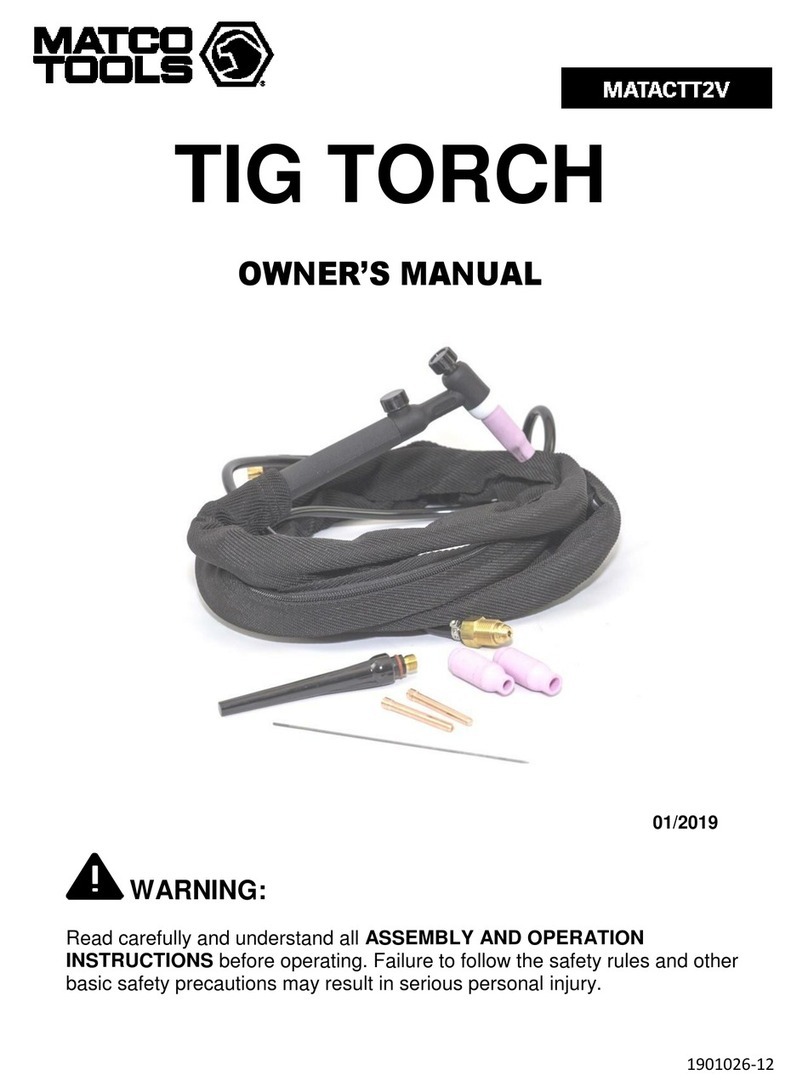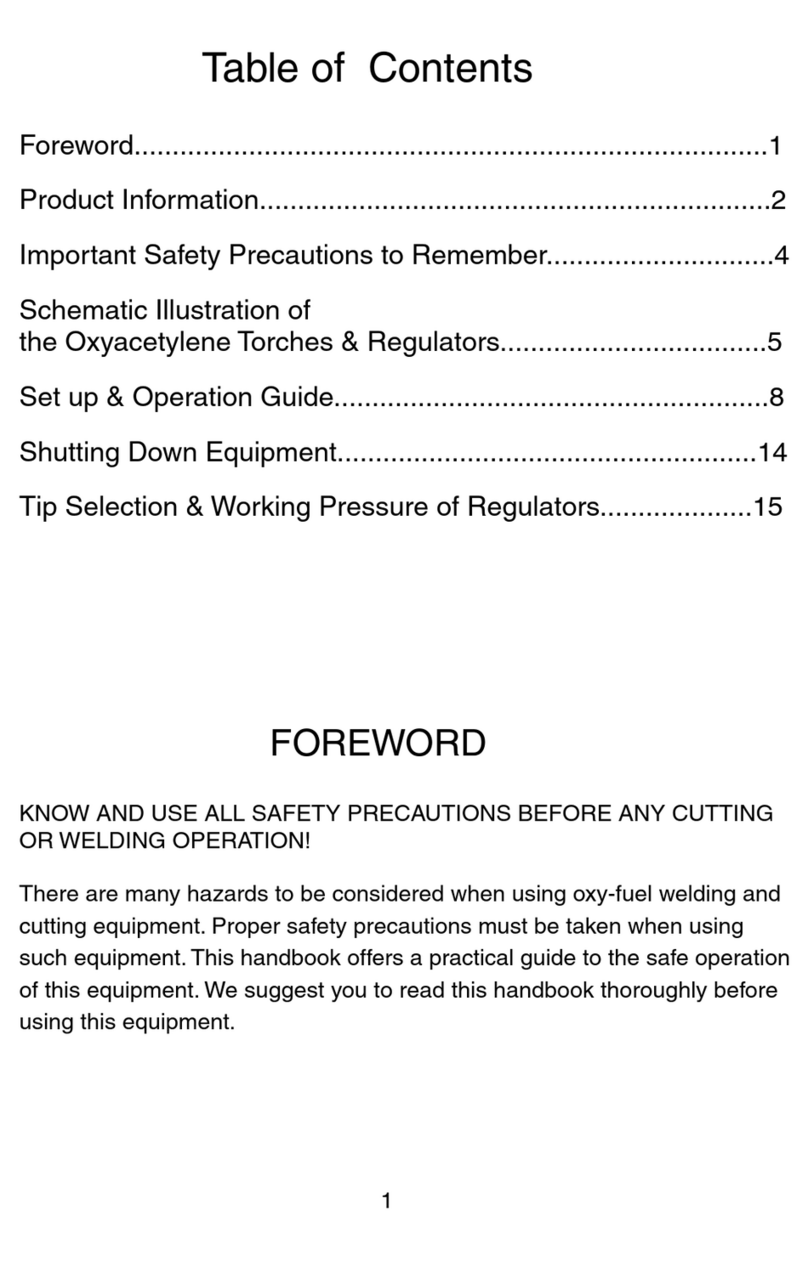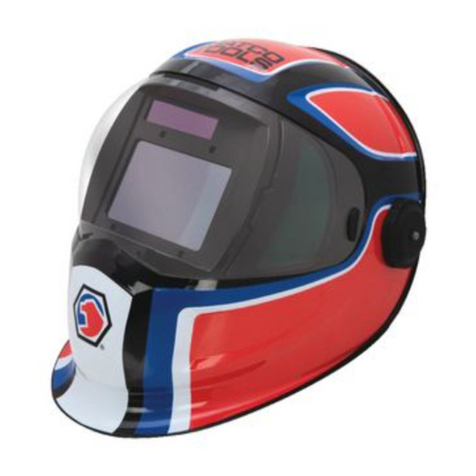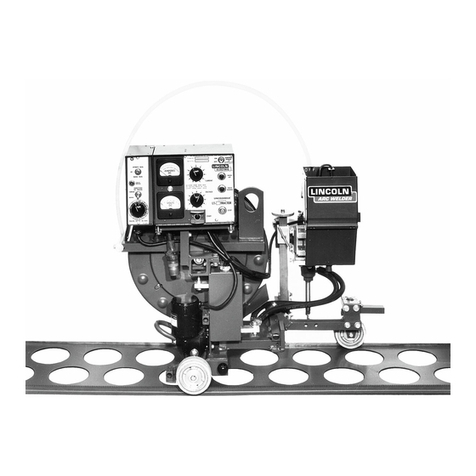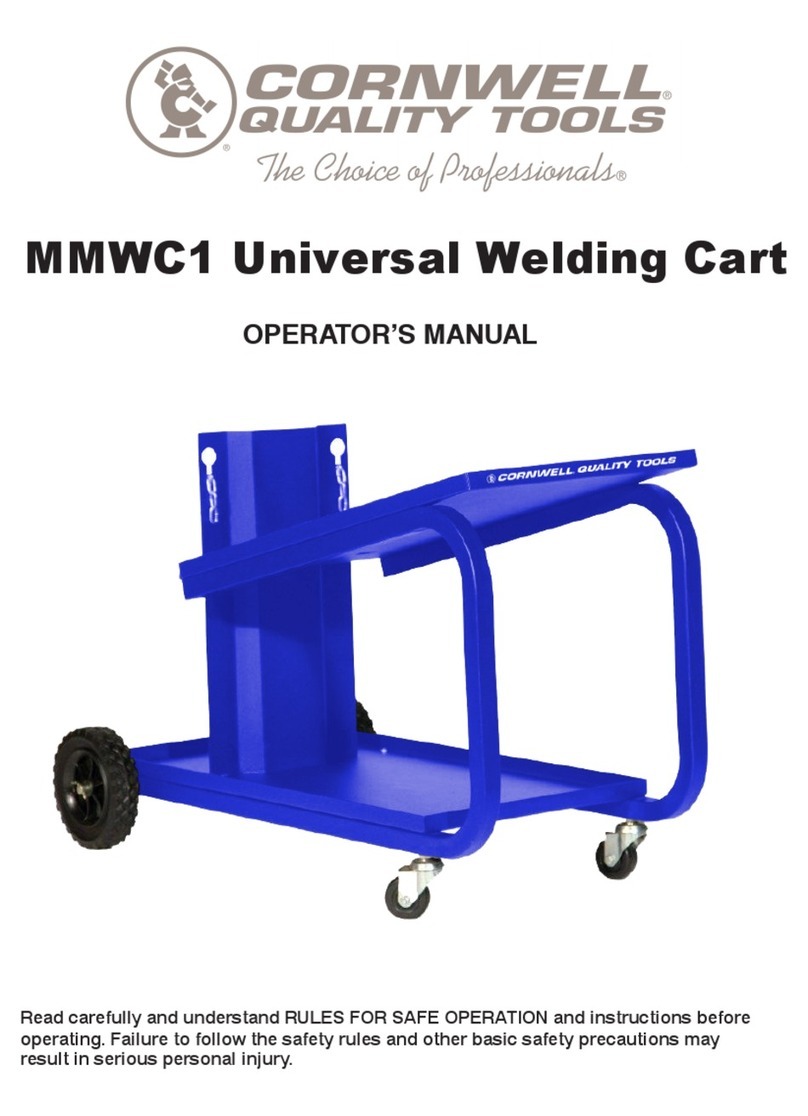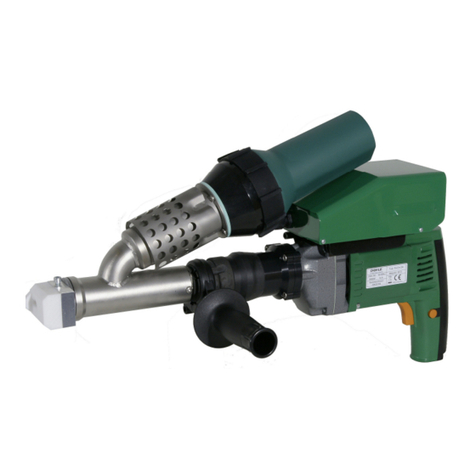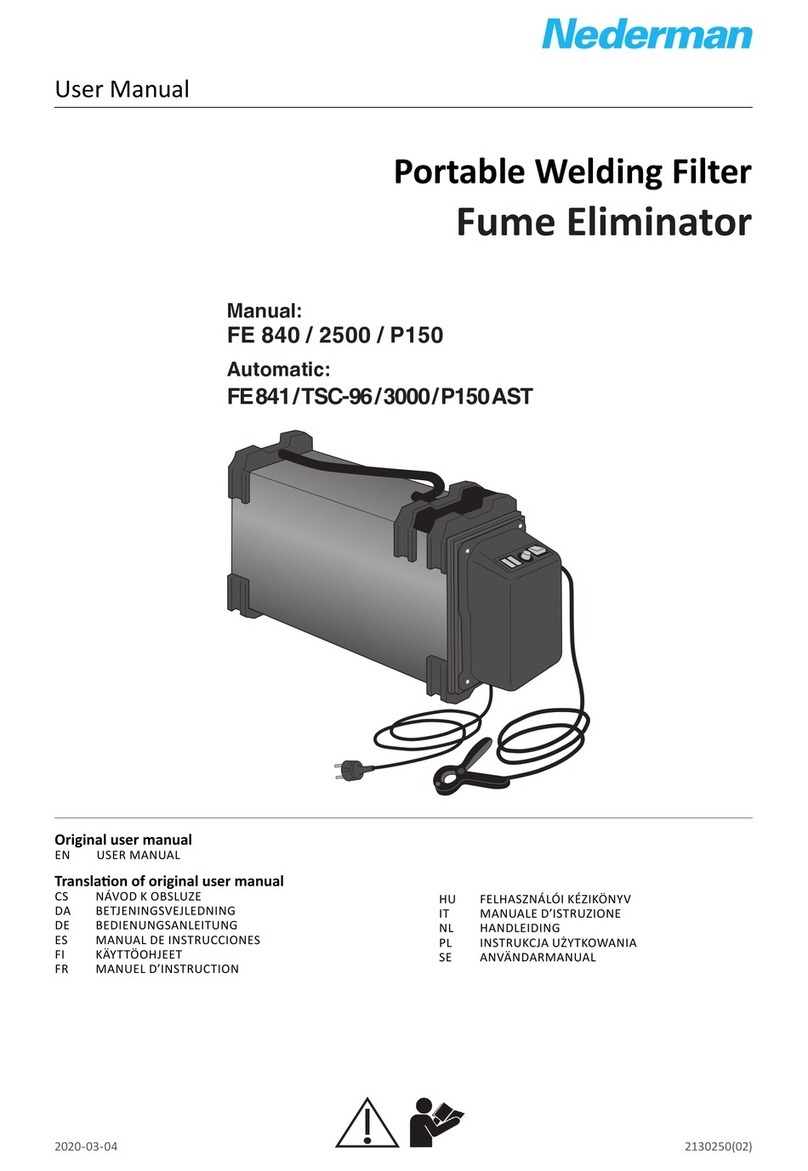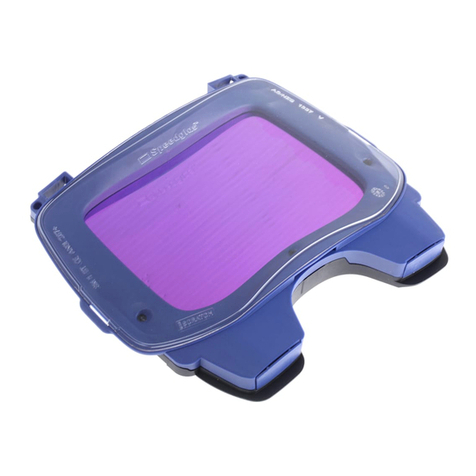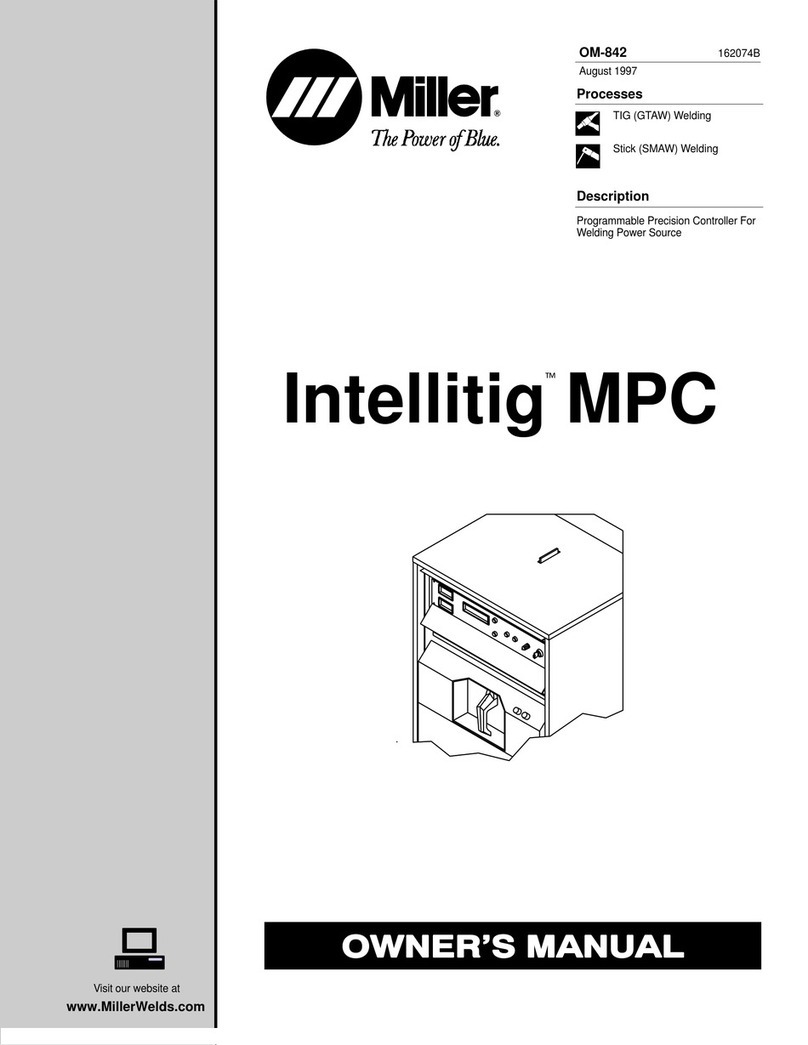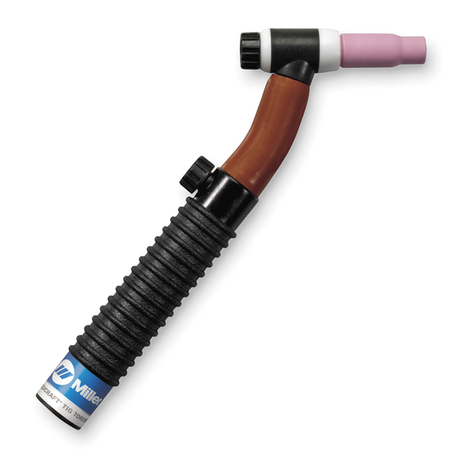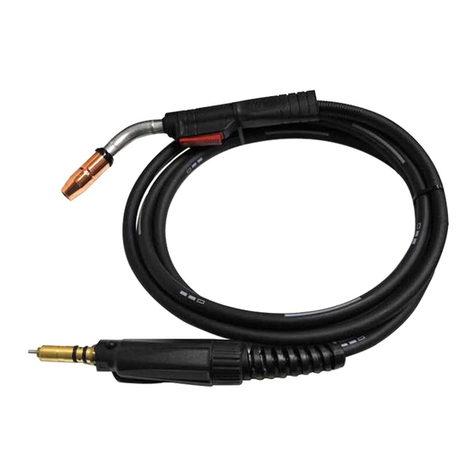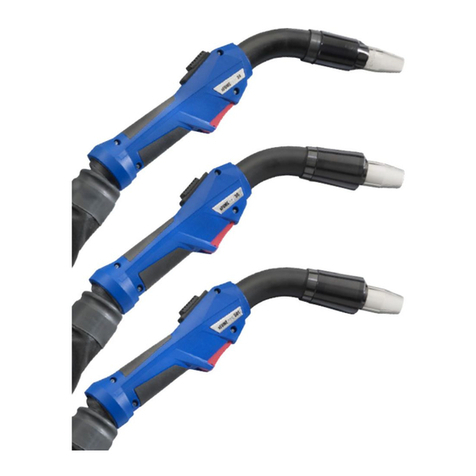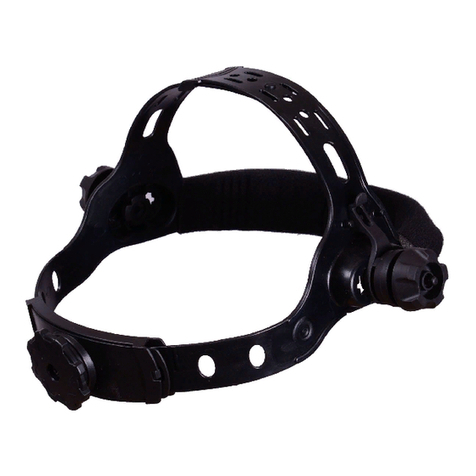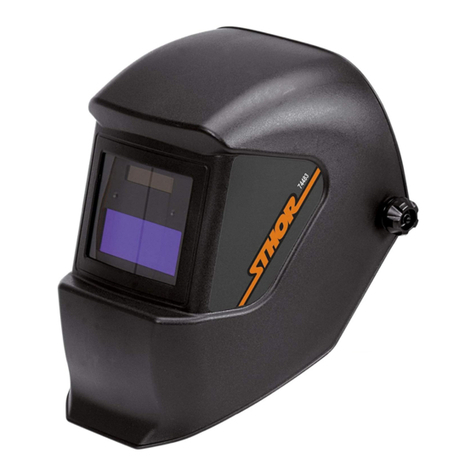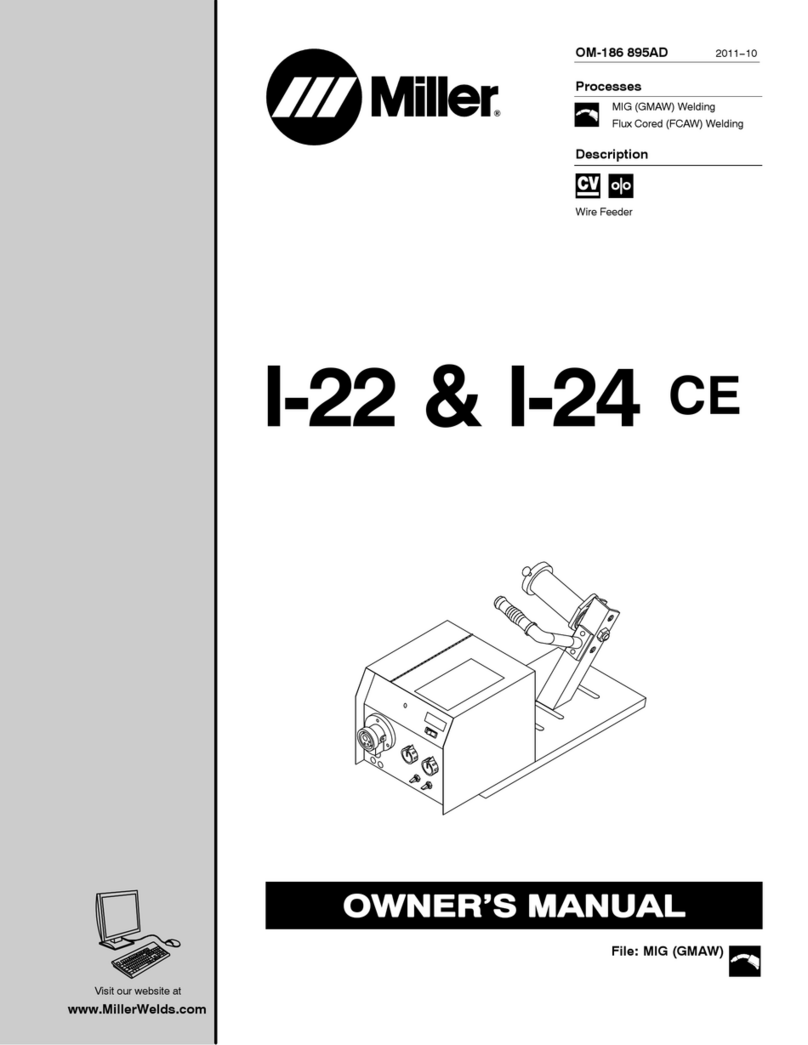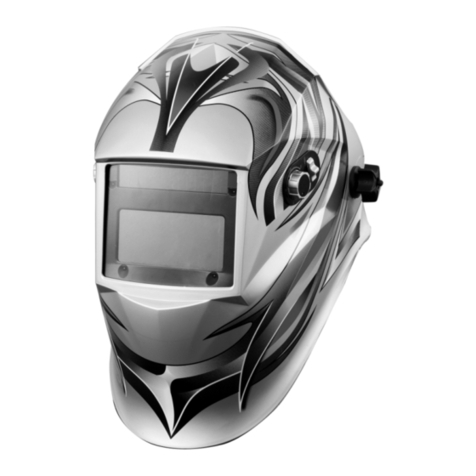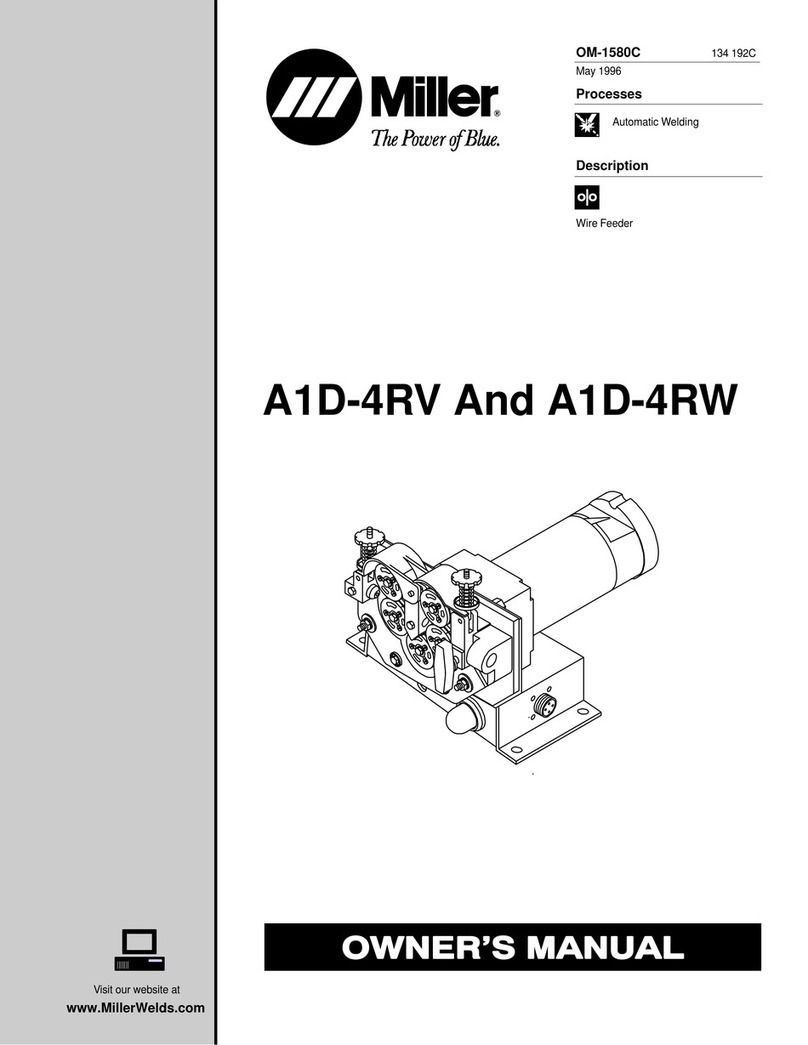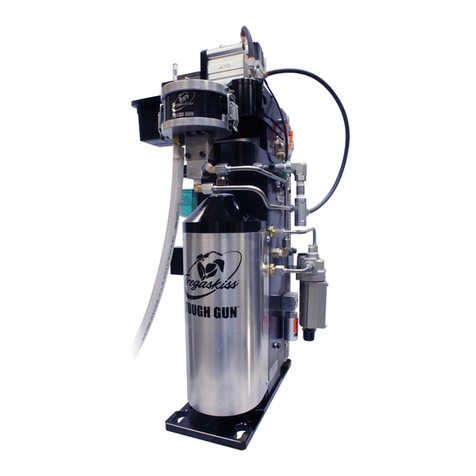Matco Tools WG3000 User manual

WG3000/
WG3000S
WG3000/
WG3000S
• Read and understand this entire instruction manual before attempting to assemble, operate, or maintain
this tool.
• Materials which may come into contact with the user’s skin could cause allergic reactions to susceptible individuals.
• Eye protectors against high speed particles worn over standard opthalmic spectacles may transmit impacts, thus
creating a hazard to the wearer.
• If protection against high speed particles at extreme temperatures is required, then the selected eye protector
should be marked with a letter "T" immediately after the impact letter, i.e, FT, BT, or AT. If the impact letter is not
followed by the letter "T", then the eye protector shall only be used against high speed particles at
room temperature.
• If protection levels are not common to different parts of the protective equipment, the lower protection level shall
be assigned.
• Toughened material filter oculars shall only be used in conjuction with a suitable backing occular.
PLEASE READ CAREFULLY & FOLLOW DIRECTIONS BEFORE USE.
BEFORE INITIAL USE:
DIGITAL WELDING GOGGLES
1
24
IMPORTANT SAFETY INSTRUCTIONS
• Welding may produce fumes and gases that are hazardous to your health. Keep your head out of the fumes. Do not
breathe in the fumes.
• If indoors, ventilate the area and/or use exhaust at the arc to remove welding fumes and gases.
• If ventilation is poor, use an approved air-supplied respirator.
• Read the manufacturer’s instructions for metals, consumables, coatings, cleaners, and degreasers.
• Do not weld in locations near degreasing, cleaning, or spraying operations. The heat and rays of the arc can react
with vapors to form highly toxic and irritating gases.
• Do not weld on coated metals, such as galvanized, lead, or cadmium plated steel, unless the coating is removed
from the weld area, the area is ventilated, and if necessary, while wearing an air-supplied respirator. The coatings
and any metals containing these elements can give off toxic fumes if welded.
• Work in a confined space only if it is well ventilated, or while wearing an air-supplies respirator. Always have a
trained watchperson nearby. Welding fumes and gases can displace air and lower the oxygen level causing injury or
death. Be sure the breathing air is safe.
ARC RAYS CAN BURN EYES
Never look at arc welding without proper eye protection. Arc rays from the welding process produce intense visible
and invisibile (ultraviolet and infrared) rays that can burn eyes and skin. Hot sparks fly off from the weld and can burn
eyes and skin.
• Wear welding goggles set at the proper shade of filter to protect your face and eyes when welding or observing
welding in progress.
• Wear approved safety glasses with side shields under your welding goggles.
• Use protective screens or barriers to protect others from flash and glare. Warn others in the area not to look at
the arc.
• Wear protective clothing made from durable, flame resistant materials, leather welding gloves, and full
foot protection.
2201014-08
Matco Tools | Stow, Ohio 44224
www.matcotools.com
NOTES / NOTAS / REMARQUES
WELDING CAN CAUSE FIRE OR EXPLOSION
Welding on closed containers, such as tanks, drums, or pipes can cause them to explode. Sparks can fly from the
welding arc. The flying sparks, hot work piece, and hot equipment can cause fires and burns. Accidental contact of
electrode to metal objects can cause sparks, explosion, overheating, or fire. Check and be sure the area is safe
before doing any welding.
• Always keep a fire extinguisher readily available and watch for fire.
• Protect yourself and others from flying sparks and hot metal.
• Do not weld where flying sparks can strike flammable material.
• Remove all flammable materials from the welding area. If this is not possible, tightly cover them with
approved covers.
• Be alert that welding sparks and hot materials from welding can easily go through small cracks and openings to
adjacent areas.
• Be aware that welding on a ceiling, floor, bulkhead, or partition can cause fire on the hidden side.
• Do not weld on closed containers such as tanks, drums, or pipes; unless they are properly prepared according to
AWS F4.1 standards.

Content
Delay Time
Settings
Display
position 5
0.2S
7
0.4S
9
0.6S
11
0.8S
13
1.0S
Delay
time
Display
position 5
Grind
model
7
Low
9
Mid
11
High
13
Max
Status
5, 7, 9, 11, 13
Long press "SHADE" button for 2S to shift between 2 modes
Switch into sensitivity mode 5 position, goggle enters into Grind mode and stay in
DIN4 light state and not darken
When the volume of battery is less than 2.4V, LOWBAT indicator will turn red.
Power on: Press the "ON" button once, then the LED light blinks 5 times and it
enters standby mode.
Manually off: Press the button lasting 2S, when the LOWBAT light is on, then release
the button.
Automatically off: Goggle will automatically turn off after 10 minutes in inactive mode
Sensitivity
Settings
Shade
Settings
Grinding
Settings
Power
On/Off
Low Volume
Alarm
Function Button
DELAY
SENS
SENS
ON
BATT
SHADE
3
2
SPECIFICATIONS
Model
View Area
Cartridge Size
Cover Lens Size
UV/IR Protection
Light State
Optical Class
Dark State
Delay Time
Sensitivity
Power On/Off
Sensors
Grinding
Sensitivity Control
Delay Control
TIG Rating
Battery Type
Operating Temperature
Storage Temperature
WG3000/WG3000S
111 x 42mm
196 x 212 x 92mm
158 x 58.6 x 1.0mm
DIN 13
DIN 4
1/1/1/2
External variable shade #5, #7, #9, #11, #13
Mode 1: #5, #7 | Mode 2: #9, #11, #13 (long press the "shade" button from
Mode 1 to Mode 2)
5 adjustments by button from fast to slow (0.2S, 0.4S, 0.6S, 0.8S, 1.0S)
5 adjustments by button from low to high (Grind mode in position 5. Welding
mode from low to high sensitivity in position 7, 9, 11, 13)
Manually on/manually long press "power" button for 2 seconds or automatically
shut off after 10min in inactive mode.
2
Yes (when sensitivity button is in position 5)
Yes
Yes
>5 AMPS
Replaceable CR2450 lithium batteries
-5˚C ~ +55˚C
-20˚C ~ +70˚C
1
2
3
4
5
6
Cover Lens
Arc Sensor
Rubber Lining
Auto-Darkening Filter I
Digital Control Panel
Elastic Headband
PART # DESCRIPTION
• Connect work cable to the work as close to the welding area as practical to prevent welding current from traveling
long, possibly unknown paths and causing electric shock and fire hazards.
• Never use arc welder to thaw frozen pipes.
• Remove electrode from holder when not in use.
• Wear oil-free protective garments such as leather gloves, heavy shirt, cuff-less trousers, high shoes, and a cap.
• Remove any combustibles such as lighters or matches from your person before doing any welding.
FLYING METAL CAN INJURE EYES
• Wear ANSI approved safety glasses with side shields under your welding goggles.
• Welding, chipping, wire brushing, and grinding cause sparks and flying metal. As welds cool, they can throw
off slag.
HOT PARTS CAN CAUSE SEVERE BURNS
• Never touch hot parts bare handed.
• Allow adequate cooling period before touching work piece.
NOISE CAN DAMAGE HEARING
• Noise from some processes or equipment can damage hearing.
• Wear approved ear protection if noise level is high.
GENERAL INFORMATION
• WG3000/WG3000S Welding Goggles do not protect against severe impact hazards such as fractured grinding
wheels or abrasive disks, explosive devices, or corrosive liquids. Machine guards or eye splash protection must be
used when these hazards are present.
• The auto-darkening welding filters are designed for arc welding or cutting applications. The unit is suitable for all arc
welding processes such as MIG, MAG, TIG, SMAW, Plasma, Arc, and Carbon arc.
• This auto-darkening welding filter is not recommended for overhead welding applications, laser welding, or laser
cutting applications.
• In the event of electronic failure the welder remains protected against UV and IR radiation according to shade 11.
• The auto-darkening welding filter should always be used with the original or OEM replacement cover lenses.
• The manufacturer is not responsible for any failure due to modifications to the welding filter or the use of the filter
from any other manufacturer’s helmet.
• If protection levels are not common to different parts of the protective equipment, the lower protection level shall
be assigned.
1 2
4 2 5 6
3
NOTE:
1. Protectors which exhibit broken parts, distortion, or excessive scratches on the lens are unsuitable for use and shall
not be worn.
2. User shall make a visual inspection of their protector prior to each use.
3. Eye and face protectors that have been subject to an impact shall not be used and shall be discarded and replaced.
OPERATION:
BEFORE WELDING
1. Please verify whether the protection film of exterior and interior glasses has been removed.
2. Please make sure that battery is full of charge if it has not been used for a long time.
3. Please verify whether display of ADF is normal if it has not been used for a long time.
4. Please verify whether solar cell is damaged or blocked by dust, and whether arc sensor is clean.
5. Please check all operating parts to see whether they are worn off or damaged. Any scratched or broken parts should
be replaced immediately so as not to incur personal injury.
6. The welding hood must be worn underneath the welding goggles and mask.
7. Please verify strap tightness before each use.
8. Please choose the right shade number according to the types of welding machines and current of welding.
DIGITAL CONTROL PANEL

45
SHADE NUMBER SELECTION
1. Shading can be manually set from 5, 7, 9, 11, 13.
Mode 1: #5, #7
Mode 2: #9, #11, #13
(Long press the "SHADE" button 2S to shift from
mode 1 to mode 2.) See Fig. 1
2. Please choose the right shade number from the
following list - according to the types of welding
machines and current of welding.
Fig. 1
Shade number selection
Fig. 2
Delay time
8
8
4 5 6 7 8 9 10 11 12
9
9 10
10
109 11 12 13
11 12 13 14
11 12 13 14
10 11 12 13
SHADE GUIDE TABLE
Welding
Process
Arc Current (Amperes)
1.5 6 10 15 30 40 60 70 100 125 150 175 200 225 250 300 350 400 450 500 600
SMAW
MAG
TIG
MIG (heavy)
MIG (light)
PAC
PAW
8 9
9
10
10
11
11 12 13 14
12 13 14
NOTE
*SMAW-covered electrodes
*MAG-metal arc welding
*TIG-Gas tungsten arc welding
*MIG-(heavy)-MIG with heavy metals
*MIG-(light)-MIG with light alloys
*PAC-plasma jet cutting
*PAW-microplama arc welding
14
DELAY TIME
0.2 at position 5, 0.4S at position 7, 0.6S at position 9, 0.8S at position 11, 1.0S at position 13. Delay time refers to
the time cost by the filter changing from dark to bright state. According to the welding current and power of light, it
can be quicker or slower by adjusting the "DELAY" button. See Fig. 2.
1. Selecting position 5, delay time will be set at 0.20S, which is
suitable to spot welding or short weld.
2. Selecting position 13, delay time will be set at 1.0S, which is
suitable to heavy current welding or when light is produced.
3. Selecting the position 7, 9, or 11 is suitable to most indoor
and outdoor welding operations.
RECOGNITION OF FAILURE OF THE AUTOMATIC WELDING FILTER
Pre-welding check: Choose the Delay time switcher to the slow or fast setting and set the sensitivity to the high
setting. Point the sensor towards a light source such as an overhead light, lamp, etc. The auto-darkening lens should
now switch to the dark state. If the auto-darkening lens is darkened, as per shade setting, the helmet is functioning
properly. If the auto-darkening lens is NOT darkening when procedures above are followed, battery replacement is
required or the auto-darkening lens may be defective.
ATTENTION: Used battery cells shall be disposed of in accordance to the law and regulations of the local
government. ADF shall be dealt with according to waste of electrical materials.
Fig. 3
Sensitivity
SENSITIVITY
Five grades 5, 7, 9, 11, and 13 are available from light to dark (when in position 5, goggle is in grind mode DIN 4 light
state and won’t darken; when in 7, 9, 11, or 13 positions, goggle is in auto-darkening mode and won’t switch to light
state. According to welding art and ambient light, it can be set through the "SENS" key. See Fig. 3.
1. Selecting position 5 is suitable to weld with heavy current, in
the bright light, or a surrounding where light is interfered.
2. Selecting position 13 is suitable to weld with low current and in
a darker place, especially to low-current argon arc welding.
3. Selecting the position 7, 9, or 11 is suitable to most indoor and
outdoor welding operations.
CELL REPLACEMENT
When the BAT indicator lights up in red, please change battery at once and please pay attention to positive and
negative terminals and replace battery according to following operations. See Fig 4.
1. Unscrew the screw with a Phillips head screwdriver.
2. Open the cover plate.
3. Change the battery.
4. Close cover plate.
5. Secure the cover plate using the screw with a Phillips head screwdriver
INSTALLATION OF THE INNER COVER LENS
Ensure the front cover lens is mounted before using and the protective film on the lens cover is removed. Ensure
that the lens is clean and there is no dirt or spatter covering the sensors and the front of the filter cartridge. Beware
that the eye protection equipment against high velocity particles may impose a hazard to the wearer by passing on
hits when worn over standard prescription eyewear. The eye protection equipment may only be applied against high
speed particles at room temperature.
FRONT COVER LENS REPLACEMENT
When any scratched or broken protective lens affects sight, please replace the protective lens without delay
according to following operations. See Fig. 5.
INSTALLATION OF THE FACE SHIELD
There are three (3) buckles on the face shield. Please confirm the buckles connect to corresponding position on the
goggles. See Fig. 6.
MAINTENANCE.
1. Please use tissues, lens wiping paper, or clean cotton cloth and detergent to clean filter.
2. Please use neutral detergent to clean out shell of welding goggles and sweatband.
3. Please replace outside and inside protector and sweatband regularly.
4. Please do not use corrosive solvent or gasoline to dilute detergent.
5. Instructions for cleaning and disinfection: Clean the welding filter with a clean lint-free tissue or cloth. Do not
immerse the helmet into water. Do not use solvents.
ADDITIONAL WARNINGS.
• The ADF is not suitable to laser welding and oxy-acetylene welding.
• Do not put welding goggles and ADF near a heat source or water.
• Do not remove ADF from the weld cap or open the case of the ADF.
• Please check whether welding/grinding is chosen correctly before use.
• Protector must be installed on the outside of the ADF, otherwise ADF may be damaged.
• Do not make any modifications or repairs to the welding goggles or ADF.
• Please immediately stop using ADF and contact dealer if filter does not become dark when welding.
• Do not use alcohol, gasoline, or dilutents to clean ADF. Do not put the case of the ADF into water.
• The reaction of the ADF’s liquid crystal will be slower if the ambient temperature is low but it will not affect
protective functions.
• Please replace the case of the ADF immediately if ADF is broken or scratched because it will affect view and
seriously reduce the protective performance.
• Please replace protector immediately if it is broken or scratched.
• Please clean surface of ADF, sensor, and sollar cells regularly.
• Welding goggles may not resist damage cause by a violent hit, explosion, or corrosive liquid.
• Frequent inspections and replacement of damaged parts is recommended.
Fig. 5 Fig. 6
Fig. 4
2
31

The Welding Goggles are backed by a 1 Year Warranty. This warranty covers manufacturer defects and workmanship. The warranty
excludes misuse or abuse and normal wear and tear. Exclusion is not allowed in some states and may not apply. This warranty gives
you specific legal rights, and you may have other rights, which vary from state to state.
WARNING: Cancer and Reproductive Harm. www.P65Warnings.ca.gov
• ARC rays can injure eyes and burn skin.
• Before welding, always inspect helmet and auto-darkening filter (ADF) to be sure they are fitted properly and
in good condition.
• Keep the sensors and filter lens clean. Clean the filter cartridge using a soapy water solution and
a soft cloth. Do not use solvents or abrasive cleaning detergent.
• Do not weld in the overhead position while using this helmet.
• Inspect the filter lens frequently and immediately replace and scratched, cracked, or pitted filter lens or
cover lens.
• Always wear safety glasses or goggles under the welding helmet, and protective clothing to protect your skin
from radiation, burns, and spatter.
GENERAL GUIDELINES AND WARNINGS:
7
6
4
Marks Explanation
Light state
5, 7, 9, 11, 13 Adjustable dark states
GX Manufacturer identification
1
Optical class
Diffusion of light class
Homogeneity class
2
Marks Explanation
Angle dependence class
379 Testing standard
175 Testing standard
GX 1 B Manufacturer identification
Optical class
BResistance against energy
impact 120m/s
FResistance against low energy
impact 45m/s
MEANING OF THE MARKS
Goggle does not
become dark
or flashes
ADF is
slow to react
Filter is
not clear
Issue Cause Solution
Protective lens is polluted or damaged
Arc sensor is not clear
Welding current is too small
Battery voltage is low
Ambient temperature is too low
Sensitivity setting is too low
Do not use in temperatures below -5°F
Raise sensitivity
Clean or replace it
Clean the surface of sensor
Adjust sensitivity to MAX
Replace battery
Protector is stained
Protective film is not removed
Filter lenses have stains
Ambient light is insufficient
Shading number is not set correctly
Adjust lighting
Reset the shading number
Clean or replace protector
Remove protective film
Wipe both sides of the filter lens
CAUTION: You should stop using the product immediately and contact dealer if the above issues cannot be resolved
with the above solutions.
TROUBLESHOOTING
• Lea y comprenda el manual de instrucciones completo antes de intentar ensamblar, operar o dar mantenimiento a
esta herramienta.
• Los materiales que entran en contacto con la piel del usuario pueden causar reacciones alérgicas a las personas
susceptibles.
• Los protectores oculares contra partículas de alta velocidad que se usan sobre anteojos de medida estándar
pueden transmitir impactos, creando así un peligro para el usuario.
• Si se requiere protección contra partículas de alta velocidad a temperaturas extremas, el protector ocular
seleccionado debe marcarse con una letra "T" inmediatamente después de la letra de impacto, es decir, FT, BT o AT.
Si la letra de impacto no va seguida de la letra "T", el protector ocular solo deberá utilizarse contra partículas de alta
velocidad a temperatura ambiente.
• Si los niveles de protección no son comunes a las diferentes partes del equipo de protección, se asignará el nivel
de protección más bajo.
• Los oculares con filtro de material endurecido solo se deben usar junto con un ocular de respaldo adecuado.
LEA LAS INSTRUCCIONES CON DETENIMIENTO ANTES DE USAR Y SÍGALAS.
ANTES DEL USO INICIAL
GAFAS DIGITALES PARA SOLDAR
INSTRUCCIONES DE SEGURIDAD IMPORTANTES
• La soldadura puede producir humo y gases peligrosos para la salud. Aleje su cabeza del humo. No respire el humo.
• Si está en interiores, ventile el área o use un escape en el arco para eliminar el humo y los gases de la soldadura.
• Si la ventilación es deficiente, use un respirador aprobado con suministro de aire.
• Lea las instrucciones del fabricante para metales, consumibles, revestimientos, limpiadores y desengrasantes.
• No suelde en lugares cercanos a operaciones de desengrasado, limpieza o rociado. El calor y los rayos del arco
pueden reaccionar con los vapores y formar gases altamente tóxicos e irritantes.
• No suelde sobre metales revestidos, como acero galvanizado, recubierto de plomo o cadmiado, a menos que se
quite el revestimiento del área de soldadura, el área esté ventilada y, si es necesario, mientras usa un respirador
con suministro de aire. Los revestimientos y cualquier metal que contenga estos elementos pueden emanar
humos tóxicos si se sueldan.
• Trabaje en un espacio confinado solo si está bien ventilado o mientras usa un respirador con suministro de aire.
Tenga siempre cerca de un vigilante capacitado. Los humos y gases de soldadura pueden desplazar el aire y reducir
el nivel de oxígeno causando lesiones o incluso la muerte. Asegúrese de que el aire que respira sea seguro.
LOS RAYOS DEL ARCO PUEDEN QUEMAR LOS OJOS
Nunca mire la soldadura por arco sin la protección ocular adecuada. Los rayos del arco del proceso de soldadura
producen rayos intensos visibles e invisibles (ultravioleta e infrarrojos) que pueden quemar los ojos y la piel. La
soldadura produce chispas calientes que salen volando y pueden quemar los ojos y la piel.
• Use gafas para soldar configuradas en el tono de filtro adecuado para proteger su rostro y ojos cuando suelde u
observe a otra persona soldar.
• Use anteojos de seguridad aprobados con protectores laterales debajo de sus gafas para soldar.
• Lea las instrucciones del fabricante para metales, consumibles, revestimientos, limpiadores y desengrasantes.
• Utilice pantallas protectoras o barreras para proteger a los demás de los destellos y el resplandor. Advierta a otros
en el área que no miren el arco.
• Use ropa protectora hecha de materiales duraderos y resistentes al fuego, guantes de cuero para soldar y
protección completa para los pies.
LA SOLDADURA PUEDE PROVOCAR INCENDIOS O EXPLOSIONES
La soldadura en contenedores cerrados, como tanques, cilindros o tuberías, puede hacer que exploten. Pueden salir
chispas del arco de soldadura. Las chispas que vuelan, la pieza de trabajo caliente y el equipo caliente pueden
provocar incendios y quemaduras. El contacto accidental del electrodo con objetos metálicos puede causar chispas,
explosión, sobrecalentamiento o incendio. Verifique y asegúrese de que el área sea segura antes de realizar cualquier
soldadura.
• Mantenga siempre un extintor de incendios a mano y esté atento a los incendios.
• Protéjase a sí mismo y a los demás de las chispas que vuelan y del metal caliente.
• No suelde donde las chispas que vuelan puedan caer sobre material inflamable.
• Retire todos los materiales inflamables del área de soldadura. Si esto no es posible, cúbralos herméticamente con
cubiertas aprobadas.
• Esté alerta de que las chispas de soldadura y los materiales calientes de la soldadura pueden pasar fácilmente a
través de pequeñas grietas y aberturas hacia zonas adyacentes.
WG3000/
WG3000S
WG3000/
WG3000S
• Tenga en cuenta que la soldadura en un techo, piso, mampara o tabique puede provocar un incendio en el
lado oculto.
• No suelde en contenedores cerrados como tanques, cilindros o tuberías; a menos que estén debidamente
preparados de acuerdo con los estándares AWS F4.1.
• Conecte el cable de trabajo a la zona de trabajo lo más cerca posible del área de soldadura para evitar que la
corriente de soldadura se desplace demasiado, posiblemente por rutas desconocidas, y provoque descargas
eléctricas y riesgos de incendio.
• Nunca use una soldadora de arco para descongelar tuberías congeladas.
• Retire el electrodo del soporte cuando no esté en uso.
• Use prendas protectoras libres de aceite, como guantes de cuero, camisa gruesa, pantalones sin dobladillo, zapatos
altos y gorra.
• Antes de empezar a soldar, asegúrese de no portar ningún tipo de combustible, como encendedores o fósforos.

89
LA SOLDADURA PUEDE PROVOCAR INCENDIOS O EXPLOSIONES
La soldadura en contenedores cerrados, como tanques, cilindros o tuberías, puede hacer que exploten. Pueden salir
chispas del arco de soldadura. Las chispas que vuelan, la pieza de trabajo caliente y el equipo caliente pueden
provocar incendios y quemaduras. El contacto accidental del electrodo con objetos metálicos puede causar chispas,
explosión, sobrecalentamiento o incendio. Verifique y asegúrese de que el área sea segura antes de realizar cualquier
soldadura.
• Mantenga siempre un extintor de incendios a mano y esté atento a los incendios.
• Protéjase a sí mismo y a los demás de las chispas que vuelan y del metal caliente.
• No suelde donde las chispas que vuelan puedan caer sobre material inflamable.
• Retire todos los materiales inflamables del área de soldadura. Si esto no es posible, cúbralos herméticamente con
cubiertas aprobadas.
• Esté alerta de que las chispas de soldadura y los materiales calientes de la soldadura pueden pasar fácilmente a
través de pequeñas grietas y aberturas hacia zonas adyacentes.
EL METAL QUE SALE VOLADO PUEDE LESIONAR LOS OJOS
• Use anteojos de seguridad aprobados por ANSI con protectores laterales debajo de sus gafas para soldar.
• La soldadura, el astillado, el cepillado con alambre y el amolado provocan chispas y metal despedido. A medida que
las soldaduras se enfrían, pueden desprender escoria.
LAS PIEZAS CALIENTES PUEDEN PROVOCAR QUEMADURAS GRAVES
• Nunca toque las piezas calientes con las manos sin protección.
• Permita un período de enfriamiento adecuado antes de tocar la pieza de trabajo.`
EL RUIDO PUEDE DAÑAR LA AUDICIÓN
• El ruido de algunos procesos o equipos puede dañar la audición.
• Use protección auditiva aprobada si el nivel de ruido es alto.
INFORMACIÓN GENERAL
• Las gafas para soldar WG3000/WG3000S no protegen contra riesgos de impactos graves, como discos de amolar o
discos abrasivos fracturados, dispositivos explosivos o líquidos corrosivos. Se deben usar protecciones para la
máquina o protección contra salpicaduras para los ojos cuando estos peligros están presentes.
• Los filtros de soldadura de oscurecimiento automático están diseñados para aplicaciones de corte o soldadura por
arco. La unidad es adecuada para todos los procesos de soldadura por arco, como MIG, MAG, TIG, SMAW, Plasma,
Arc y Carbon arc.
• Este filtro de soldadura de oscurecimiento automático no se recomienda para aplicaciones de soldadura por encima
de la cabeza, soldadura por láser o de corte por láser.
• En caso de fallo electrónico, el soldador sigue protegido contra la radiación UV e IR con el tono 11.
• El filtro de soldadura de oscurecimiento automático siempre debe usarse con las lentes de cubierta de repuesto
originales u OEM
• El fabricante no se responsabiliza por ninguna falla debida a modificaciones en el filtro de soldadura o al uso del
filtro de un casco de cualquier otro fabricante.
• Tenga en cuenta que la soldadura en un techo, piso, mampara o tabique puede provocar un incendio en el
lado oculto.
• No suelde en contenedores cerrados como tanques, cilindros o tuberías; a menos que estén debidamente
preparados de acuerdo con los estándares AWS F4.1.
• Conecte el cable de trabajo a la zona de trabajo lo más cerca posible del área de soldadura para evitar que la
corriente de soldadura se desplace demasiado, posiblemente por rutas desconocidas, y provoque descargas
eléctricas y riesgos de incendio.
• Nunca use una soldadora de arco para descongelar tuberías congeladas.
• Retire el electrodo del soporte cuando no esté en uso.
• Use prendas protectoras libres de aceite, como guantes de cuero, camisa gruesa, pantalones sin dobladillo, zapatos
altos y gorra.
• Antes de empezar a soldar, asegúrese de no portar ningún tipo de combustible, como encendedores o fósforos.
ESPECIFICACIONES
Modelo
Área de visión
Tamaño del cartucho
Tamaño de la lente de cubierta
Protección UV/IR
Estado claro
Clase óptica
Estado oscuro
Tiempo de retardo
Sensibilidad
Encendido/apagado
Sensores
Amolado
Control de sensibilidad
Control de retardo
Clasificación TIG
Tipo de batería
Temperatura de funcionamiento
Temperatura de almacenamiento
WG3000/WG3000S
111 x 42mm
196 x 212 x 92mm
158 x 58.6 x 1.0mm
DIN 13
DIN 4
1/1/1/2
Tono variable externo #5, #7, #9, #11, #13
Modo 1: #5, #7 | Modo 2: #9, #11, #13 (mantenga presionado el botón "shade"
(tono) del Modo 1 al Modo 2).
5 ajustes por botón de rápido a lento (0,2 s, 0,4 s, 0,6 s, 0,8 s, 1,0 s)
5 ajustes por botón de menor a mayor (modo de Amolado en posición 5. Modo
de soldadura de baja a alta sensibilidad en posición 7, 9, 11, 13)
Encienda manualmente/mantenga presionado el botón "encendido" durante 2
segundos o se apaga automáticamente después de 10 minutos en
modo inactivo.
2
Sí (cuando el botón de sensibilidad está en la posición 5)
Sí
Sí
>5 AMPS
Baterías de litio CR2450 reemplazables
-5˚C ~ +55˚C
-20˚C ~ +70˚C
1
2
3
4
5
6
Lente de cubierta
Sensor de arco
Revestimiento de goma
Filtro de oscurecimiento automático
Panel de control digital
Banda elástica
PART # DESCRIPTION
1 2
4 2 5 6
3
NOTA:
1. Los protectores con partes rotas, distorsión o exceso de rayones en la lente no son aptos para el uso y no
deben usarse.
2. El usuario deberá realizar una inspección visual de su protector antes de cada uso.
3. Los protectores para los ojos y el rostro que hayan sufrido un golpe no deben usarse y deben desecharse
y reemplazarse.
This manual suits for next models
1
Table of contents
Languages:
Other Matco Tools Welding Accessories manuals
